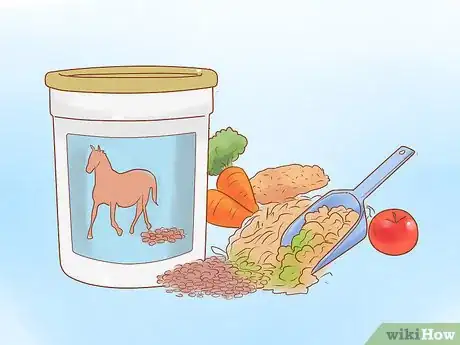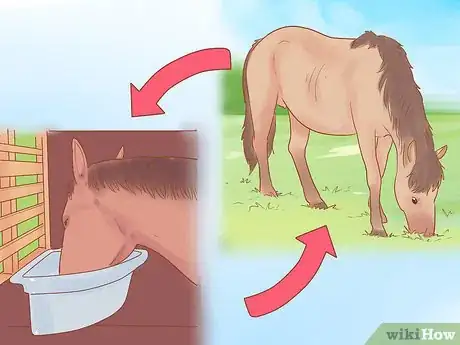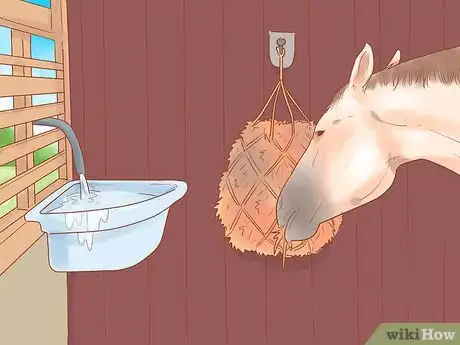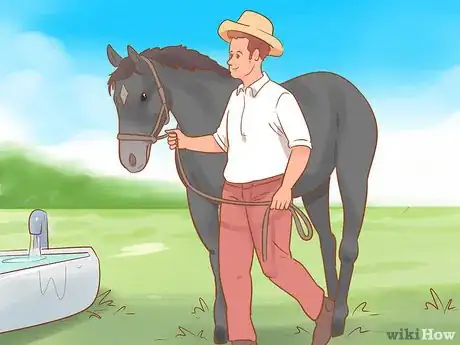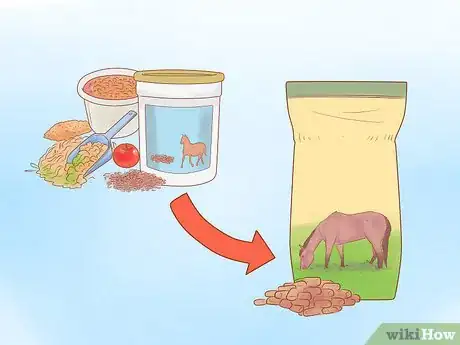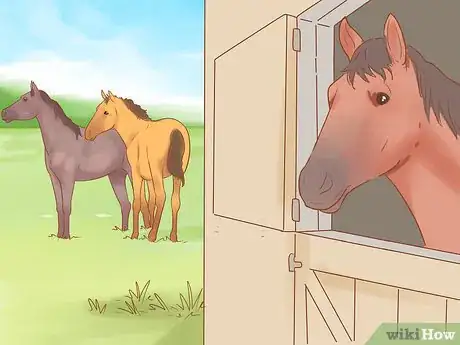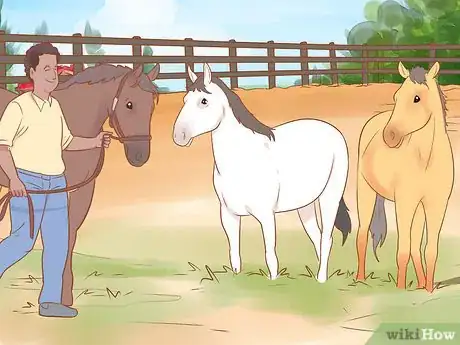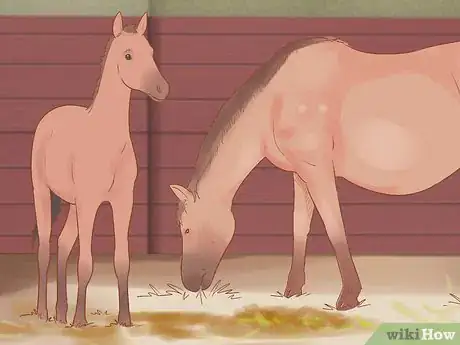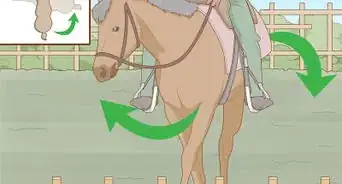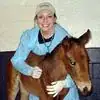This article was co-authored by Ryan Corrigan, LVT, VTS-EVN. Ryan Corrigan is a Licensed Veterinary Technician in California. She received her Bachelor of Science in Veterinary Technology from Purdue University in 2010. She is also a Member of the Academy of Equine Veterinary Nursing Technicians since 2011.
There are 9 references cited in this article, which can be found at the bottom of the page.
This article has been viewed 58,988 times.
Settling a horse into new surroundings can be stressful, both for you and your horse. Introducing your horse to other horses at its new home can also be fraught with tension. Horses like familiar surroundings, so a big move can be difficult. Making your horse feel welcome and relaxed can take a lot of work, but with a little care and effort on your part, it will feel right at home in no time.
Steps
Easing Your Horse’s Transition
-
1Prepare your horse’s new area. Before your horse arrives, you’ll want to bed down the stable, prepare its water, and get the hay net ready. After doing this, go around and double check fencing and gates just to make sure everything is secure.[1]
- When getting any equipment ready, make sure you thoroughly clean it before your horse arrives to prevent the spread of disease. To disinfect equipment, dilute 5 tablespoons (74 mL) of household bleach per 1 gallon (3.8 L) of water.[2]
- Try to use the same bedding as the horse’s old home if you can.
-
2Bring along familiar grain, hay, and water. Your horse won’t be able to adapt to sudden changes to its supply of food and water, so you’ll want to bring along a supply of your horse’s usual feed and water. You can then gradually introduce new water and feed to this.[3]
- You’ll want to consult your veterinarian if you have any questions about changing your horse’s diet.
- Gradually change the horse’s feed over a few weeks if you have to.
- You can also add sugar or Kool-Aid to your horse’s water a few weeks before the move and then add it to its new water supply to help your horse adjust to the water at its new barn.[4]
Advertisement -
3Settle your horse into a familiar routine. Your horse will likely find its move to new surroundings incredibly stressful. To ease your horse’s transition, you’ll want to provide it with a comforting and predictable routine.[5]
- Keep your horse’s feeding and turnout schedule as similar as possible to what it’s used to.
- Make any necessary changes to its feeding and turnout schedule gradually.
-
4Put your horse into its new stall or paddock with hay and water. You’ll want to give your horse a few hours to become accustomed to the new smells, sounds, and sights of its new surroundings in a confined space that is safe and comfortable.[6]
- Make sure you put enough hay and water in the stall (or small paddock if it will be at pasture).
-
5Walk your horse around its new home. After giving your horse some time to settle down and become familiar with the smells and sounds of its new home, you can take it out for a walk. Use this walk to introduce your horse to its new home. Show it the boundaries of the property and its new water trough.[7]
- During this walk, you should let your horse explore at its own pace.
- If your horse wants to graze, go ahead and let it do so.
-
6Shower your horse with love. Be sure to give your horse lots of attention during its first few days in new surroundings. Show your affection with hugs, kisses and pats. Spend as much time as possible with your horse with some good quality grooming sessions, or just sit next to it and talk, read, or listen to music. Use this time to bond with your horse.[8]
- Grooming sessions are a great way to keep your horse calm and relaxed.
-
7Refrain from riding or working your horse. During the first few days, don’t overload your horse with activities. You’ll want to give it a light schedule to ease the adjustment.[9]
- Give it about week after the move before you start putting your horse to work.
-
8Change to a new feed gradually over a week. If you’re introducing your horse to a new feed, you’ll need to do it slowly. During the first few days, replace a small portion of your horse’s old feed with the new. Then, over the next week, gradually increase the percentage of the new feed in the mix. This method will help prevent colic by giving the bacteria in your horse’s gut time to adjust to the new feed.[10]
- Start with a 3:1 ratio of old feed to new during the first 2 days. Then transition to a 2:2 ratio during days 3 and 4, and a 1:3 ratio on days 5 and 6. By day 7, you can give your horse just the new feed.[11]
- Consult your veterinarian if you have any concerns about colic or other dietary issues.
-
9Consult with your veterinarian about sedation. If your horse is extra worked up and very stressed by the new surroundings, it could be safer for everyone involved to have your vet sedate your horse while it acclimates. This keeps your horse from hurting itself in its stall or on the property, and prevents harm to other people.[12]
- The effects of sedation will last anywhere from 30 minutes to 1 hour and 30 minutes, depending on how your horse’s body reacts to the medication.
- Don’t let your horse eat or move around while it’s sedated.
Introducing Your Horse to Other Horses
-
1Isolate your horse for at least three weeks. Keeping a new arrival separate from other horses is important because it will help protect against the spread of disease. Horses can be infected with a disease without displaying any visible symptoms, so even if your horse looks healthy, it might not be. If a horse is infected, the three-week isolation period will allow enough time for any symptoms to become visible.[13]
- During the isolation period, put the horse in a place where it can see other animals without coming into direct contact with them.
- Make sure other horses are out of the range of flying droplets from horse snorts or coughs.
-
2Consider the horses’ temperaments. Before you choose pasture mates for your horse, you’ll want to think carefully about all the horses’ temperaments. If your horse is usually low in the herd hierarchy, you won’t want to pasture it together with a more dominant horse that may pick on it.[14]
-
3Let your horse see its future pasture mates up close. After keeping your horse in isolation, move it out to the open field or stable where it can see the other horses at a closer distance. Let your horse become familiar and comfortable with their presence without being able to come into direct contact with one another.[15]
- During this step, make sure that there is a physical barrier between the horses.
- Use 2 smaller pastures that share a fence if you can.
-
4Introduce the horses in a familiar setting. Now that you’ve given your horse the chance to walk through its new surroundings, it is time to introduce it to its new pasture mates. Start by turning it out with just one other horse, and then introduce it to the herd. Stand back and let the horses get to know one another.[16]
- Don’t be concerned if there’s sniffing, squealing, and face-pulling. This is completely normal.
- You should watch the initial meetings carefully, just in case there is an incident. Be watchful for signs of aggressive behavior such as pinned ears or kick threats.
-
5Delay the move for a filly or mare that is in season. If you’re moving a filly or a mare to a new field with other horses, you’ll want to wait until it is not in season. The excessive hormones may make the horses a little overexcited.[17]
Warnings
- Don't leave a horse's water container empty.⧼thumbs_response⧽
- Maintain a consistent feeding schedule. Major changes in your horse’s feeding protocol can increase the risk of colic.⧼thumbs_response⧽
- If your dog shows aggression towards the horse, take it away.⧼thumbs_response⧽
References
- ↑ https://www.horseandhound.co.uk/features/how-to-settle-a-horse-into-a-new-yard-617858
- ↑ https://www.state.nj.us/agriculture/pdf/simpledisinfectionprotocolEHV.pdf
- ↑ https://www.horseillustrated.com/horse-keeping-helping-horses-acclimate-to-a-new-home
- ↑ https://equusmagazine.com/management/newbarn
- ↑ https://equusmagazine.com/management/newbarn
- ↑ https://equusmagazine.com/management/newbarn
- ↑ https://equusmagazine.com/management/newbarn
- ↑ https://equusmagazine.com/management/newbarn
- ↑ https://www.horseillustrated.com/horse-keeping-helping-horses-acclimate-to-a-new-home
- ↑ https://equusmagazine.com/management/newbarn
- ↑ http://www.horsefeedblog.com/2013/08/transitioning-your-horse-to-a-new-feed/
- ↑ https://equusmagazine.com/management/sedation-recovery
- ↑ https://www.horseandhound.co.uk/features/how-to-settle-a-horse-into-a-new-yard-617858
- ↑ https://equusmagazine.com/management/newbarn
- ↑ https://www.horseandhound.co.uk/features/how-to-settle-a-horse-into-a-new-yard-617858
- ↑ https://equusmagazine.com/management/newbarn
- ↑ https://equusmagazine.com/management/newbarn

